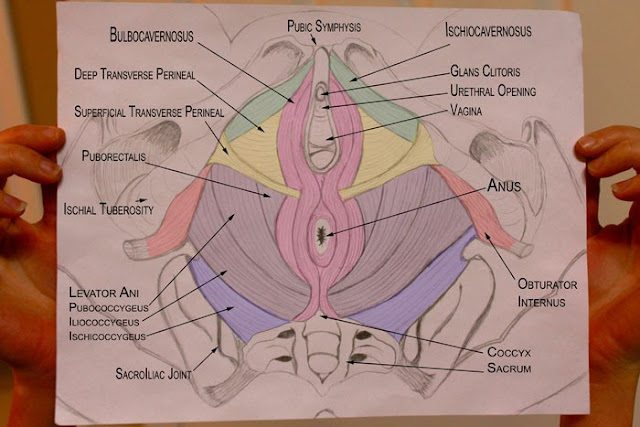Pelvic Floor Muscles and Pregnancy
The muscles of the pelvic floor are pretty amazing. They have many different roles including bladder and bowel control, supporting the pelvic organs, sexual function and core stability. During pregnancy and childbirth, these muscles take on the additional task of supporting the weight of your baby and then allowing the baby to pass through for delivery.
These diagrams depict the pelvic floor muscles as they are normally and then during childbirth.
 |
| Pelvic Floor Muscles at rest |
 |
| Pelvic Floor Muscles when the baby is crowning |
When I talk about the pelvic outlet, I'm referring to the space between the bony features of the pelvis - the pubic bones, sit bones (ischial tuberosities) and tailbone. To open the pelvic outlet, the sacrum and tailbone need to untuck and move (relatively) backwards, therefore increasing the space between the bones and lengthening the muscles. This requires good flexibility of the muscles all around the pelvis and hips. A good way to do this is to squat! Not just the kind of weighted squatting done at the gym but the deep squatting position that most of the Westernised world has forgotten about since the invention of toilets. Check out Katy Bowmans 'You Don't Know Squat' for good technique and stretches to lead up to the squat.
Squatting helps to lengthen the muscles of the pelvic floor and also the those all around the hips and pelvis which are vital to allow a baby to pass through. If you are hoping for a vaginal delivery of your baby with then you need to start preparing for it as early as possible during (or even before) your pregnancy. Having good awareness of your pelvic floor muscles, knowing how to engage and relax the muscles before your delivery can lead to a decreased risk of perineal tearing and better recovery afterwards. This means a faster and smoother delivery for your baby and less postpartum problems in the future! A Pelvic Health Physiotherapist can help train your pelvic floor muscles beforehand and also teach other manual techniques to prepare the perineal tissues and muscles for childbirth.
See the Find A Physiotherapist tab if you want to find a registered practitioner and feel free to comment or ask questions!


